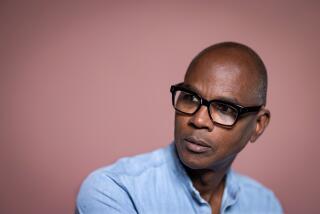Collector Talks About Dollars and Sense of Art
“You can’t seriously look at art as an investment,” Los Angeles art collector Eli Broad said Thursday to members of the Crescendo chapter of the Guilds of the Orange County Performing Arts Center. “Like a house, if you love where you live, you don’t sell it.
“I often say that when your art appreciates in value, what happens is your insurance bill goes up.” The women, meeting at Santa Ana’s Ebell Club, laughed to hear such a down-to-earth assessment.
Broad, 54, is president and chief operating officer of Kaufman & Broad Inc., a housing and financial services company. The founding chairman of the board of trustees of the Museum of Contemporary Art in Los Angeles, he began to collect art in the early 1970s. Beginning with the Impressionist and Postimpressionist work that initially caught his eye, Broad (rhymes with “road”) eased his way into contemporary art.
His flat, uninflected speech patterns Thursday masked the fervor of a crusader for the “challenge” of art of our time. “You’ll find students and artists through history are really in the forefront of . . . major movements and changes that most of us can’t accept at the time,” he said before the lecture. “The same thing is true of third-party movements throughout American (political) history. Third-party planks get adopted by one or more of the major parties.”
At home, Broad and his wife, Edye, are surrounded by the work of “what I call contemporary masters”--such as Roy Lichtenstein, Jasper Johns and Frank Stella--as well as art by earlier 20th-Century brand names such as Modigliani, Giacometti, Miro and Henry Moore.
“When I first saw the (Stellas), about 1976 or ‘77, I thought he’d gone berserk,” Broad said. “Two years later I just had to have one.”
In selecting art for his offices, he said, “I had one rule: If you’re unhappy after six months (of living with the art), we’ll change it, but you have to live with it for six months.
“Among the worst things a company can do is just hire an interior designer and get wall decoration. If you couple that with the (designer) dealing with every individual on what they want in their office or hallway, you wind up spending a lot of money and ending up with a very, very poor collection. . . . It will not have any unifying quality to it.”
Broad is big on unifying themes. Four years ago, when he began to realize that much of the art he was seeing in galleries and studios seemed inappropriate for either home or office--because of uncomfortable subject matter or unwieldy size--he created the Eli Broad Family Foundation to scoop up American art of the 1980s.
This still-growing collection, supervised by two curators, includes more than 250 works acquired expressly for loan to museums and other nonprofit exhibition spaces worldwide.
Three paintings from the foundation--Eric Fischl’s “Haircut,” Ross Bleckner’s “Brothers’ Sword” and Tim Ebner’s “Color Cue No. 3”--have been on view at the Newport Harbor Art Museum in “CalArts: Skeptical Belief(s).” A fourth painting in the exhibit, David Salle’s “The Loneliness of Clothes,” belongs to the Broad family. The exhibit ends Sunday.
“I like to acquire with my eye, as they say, rather than with my ear,” Broad said about his independent decisions about which art to buy. He stresses the need to spend time learning about art before whipping out a checkbook.
Reading, discussions with curators and active looking all play a part in his own educational process. On one of his monthly trips to New York, Broad said, he might stop in at 20 or 30 galleries and artists’ studios and visit four museum shows.
“I know everything about a piece I purchase,” he told the Crescendo chapter members, “including the period in which it was done, how it relates to society at that time, how it fits into the artist’s body of works.”
Was it initially awkward to have direct dealings with artists?
“It’s probably uncomfortable for both the artist and the collector at first because we come from very different worlds,” Broad said. “Here I am, a businessman dressed in a suit or whatever, and he’s an artist with a whole different history. So, you know, you’re reticent to communicate. Now I feel more comfortable. I spend more time looking than talking, frankly.
“Some artists are very shy and almost tremble when you enter their studio. Other artists knew exactly who I am and wondered how our stock did that day.”
More to Read
The biggest entertainment stories
Get our big stories about Hollywood, film, television, music, arts, culture and more right in your inbox as soon as they publish.
You may occasionally receive promotional content from the Los Angeles Times.










